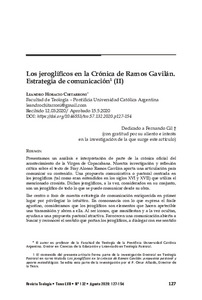Por favor, use este identificador para citar o enlazar este ítem:
https://repositorio.uca.edu.ar/handle/123456789/10542| Título : | Los jeroglíficos en la Crónica de Ramos Gavilán : estrategia de comunicación (II) Hieroglyphs in the Chronicle of Ramos Gavilán : communication strategy (II) |
Autor : | Chitarroni, Leandro Horacio | Palabras clave : | JEROGLIFICOS; VIRGEN DE COPACABANA; CRONICAS; ESTRATEGIAS DE COMUNICACION; Ramos Gavilán, Alonso | Fecha de publicación : | 2020 | Editorial : | Pontificia Universidad Católica Argentina. Facultad de Teología | Cita : | Chitarroni, H. L. Los jeroglíficos en la Crónica de Ramos Gavilán : estrategia de comunicación [en línea]. Teología. 2020, 57 (132). doi:10.46553/teo.57.132.2020.p127-154. Disponible en: https://repositorio.uca.edu.ar/handle/123456789/10542 | Resumen : | Resumen: Presentamos un análisis e interpretación de parte de la crónica oficial del acontecimiento de la Virgen de Copacabana. Nuestra investigación y reflexión crítica sobre el texto de Fray Alonso Ramos Gavilán aporta una articulación para comunicar su contenido. Una propuesta comunicativa o pastoral centrada en los jeroglíficos (tal como eran entendidos en los siglos XVI y XVII) que utiliza el mencionado cronista. Dichos jeroglíficos, a la vez, considerados en su conjunto, son un jeroglífico de todo lo que se puede comunicar desde su obra.
Ese centro o foco de nuestra estrategia de comunicación enriquecida en primer lugar por privilegiar lo intuitivo. En consonancia con lo que expresa el fraile agustino, consideramos que los jeroglíficos son elementos que hacen apetecible una transmisión y abren a ella. Al ser iconos, que manifiestan y a la vez ocultan, ayudan a una propuesta pastoral atractiva. Favorecen una comunicación abierta a buscar y reconocer el sentido que portan los jeroglíficos, a dialogar con ese sentido y a intentar corresponderle vitalmente. En definitiva, de este modo, nos parece que pueden colaborar a una pastoral basada en el protagonismo del receptor, ya sea colectivo o individual.
Abierto a ulteriores profundizaciones y desarrollos, el jeroglífico resplandece en lo presentado y puede guiar ese itinerario a seguir. En este caso la propia Virgen de Copacabana es presentada como jeroglífico, mediante la figura de la piedra y perla preciosa que atrae y llena de vida estos pueblos y tierras. Ella, mirando al verdadero Sol, asume y re-significa los sentidos prehispánicos del ídolo del mismo nombre y el del sol, y las praxis ligadas al culto de ambos. Así, María, como luna, estrella y diamante, refleja la Luz verdadera y la deja pasar por su ser, y puede ayudarnos a hacer de nuestra vida un cielo. Abstract: We present an analysis and interpretation of part of the official chronicle of the event of the Virgin of Copacabana. Our research and critical reflection on the text of Fray Alonso Ramos Gavilán provides an articulation to communicate its content. A communicative or pastoral proposal centered on the hieroglyphs used by the mentioned chronicler. These hieroglyphs, at the same time, considered as a whole, are a hieroglyph of everything that can be communicated from his work. That center or focus of our communication strategy, is enriched by prioritizing the intuitive. In keeping with what the Augustinian friar expresses, we consider that the hieroglyphics are elements that make a transmission desirable and open to it. Being icons, which manifest and hide, helps to make an attractive pastoral proposal. They also help to be an open communication, to recognize the meaning that the hieroglyphs carry, and to dialogue with that meaning and try to correspond to it vitally. In short, in this way, we believe that they can collaborate in a pastoral or open communication with the protagonism of the receiver, be it collective or individual. What shines in this presentation -which is open to future developments- is the Virgin of Copacabana precisely as a hieroglyph: stone and precious pearl, that attracts and files the life of these peoples and lands. She is looking at the true Sun and assumes and re-signifies the prehispanic senses of the idol of the same name, and praxis linked to her cult and that of the sun. Thus, like moon, star and diamond, it reflects the true Light and lets it pass through its being and can help us make our life a heaven. |
URI : | https://repositorio.uca.edu.ar/handle/123456789/10542 | ISSN : | 0328-1396 (impreso) 2683-7307 (online) |
Disciplina: | TEOLOGIA | DOI: | 10.46553/teo.57.132.2020.p127-154 | Derechos: | Acceso abierto |
| Aparece en las colecciones: | TEO - 2020 Tomo LVII nro. 132 |
Ficheros en este ítem:
| Fichero | Descripción | Tamaño | Formato | |
|---|---|---|---|---|
| jeroglificos-cronica-ramiro-gavilan.pdf | 1,22 MB | Adobe PDF |  Visualizar/Abrir |
Visualizaciones de página(s)
117
comprobado en 30-abr-2024
Descarga(s)
328
comprobado en 30-abr-2024
Google ScholarTM
Consultar
Altmetric
Este ítem está sujeto a una licencia Creative Commons Licencia Creative Commons

